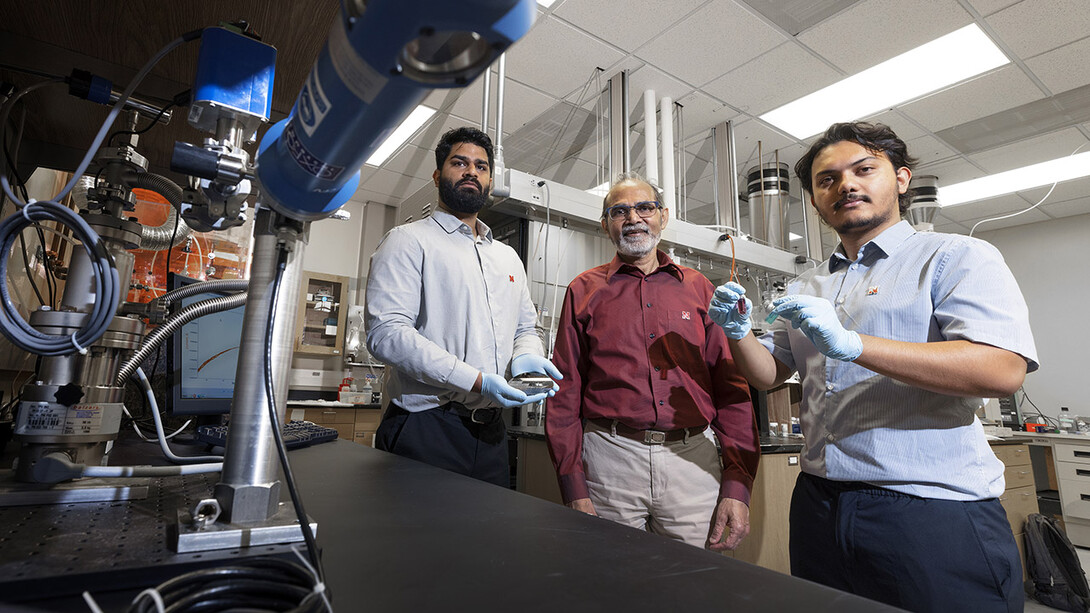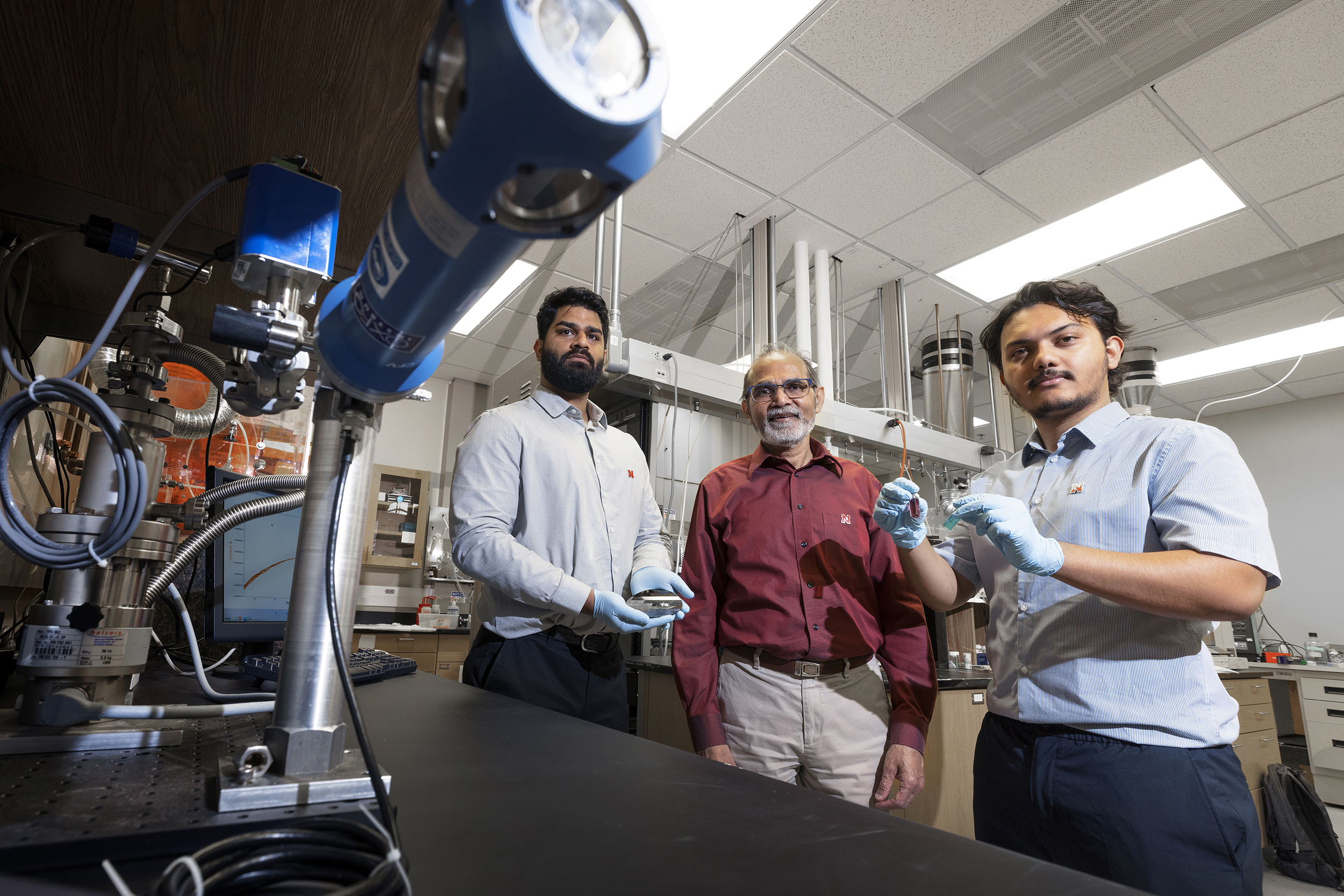
A University of Nebraska–Lincoln researcher is one step closer to developing a new kind of transistor chip that harnesses the biological responses of living organisms to drive current through the device, shedding light on cellular activity at an unprecedented level of sensitivity. Eventually, this “living” chip may enable faster and simpler diagnosis of sepsis, illuminate understanding of antibiotic resistance and bolster efforts to develop neuromorphic devices, which mimic the human brain.
In an article recently published in ACS Applied Nano Materials, Ravi Saraf details his team’s development of tiny networks of self-assembling necklaces made of gold particles. Each network spans about 25 micrometers, roughly a quarter of the diameter of a human hair. When connected, these networks serve as a conduit for current that can be regulated to form a transistor.
The networks’ structural complexity makes the transistor about 1,000 times more responsive to external stimuli than today’s most advanced metal devices.
The study marks the first time a gold necklace structure has been used in a transistor, and the approach is enabling Saraf’s team to overcome a longstanding obstacle in this area of device physics. To date, scientists have relied on what’s called the Coulomb blockade effect — a method that controls the current by charging certain nanoparticles with a single electron — to develop small, highly sensitive metal transistors with low power requirements. But this process only works at the extremely low temperature of about minus 325 degrees Fahrenheit, limiting its application.
The necklace-like morphology circumvents that problem by introducing a complex network that dictates the channels through which current can pass. Saraf analogized the setup to the thousands of interstates, highways, streets and dirt roads that connect the East and West coasts of the United States. Under the conventional Coulomb blockade approach, the “traffic flow,” or current, is regulated by putting up small barricades, in the form of a single electron charge, across most major thoroughfares. But at room temperature, the barriers are overcome, erasing the effect.
Saraf’s innovation enables a more effective approach to controlling the traffic flow: opening and closing parts of the network’s conduction channels.
“The roads were always there, but what we are doing is regulating the traffic flow by controlling which roads are being used,” said Saraf, Lowell E. and Betty Anderson Distinguished Professor of chemical and biomolecular engineering. “Now that it’s an entire additional set of roads participating, the current increases a lot. By opening more roads, you can make a device with identical current transport characteristics to a cryogenic all-metal transistor working on Coulomb blockade, but that functions at room temperature, and the regulation of current can be over 1,000-fold higher.”
Saraf said the networks’ architecture can be tailored to introduce additional properties such as electroluminescence or magnetism through a process called nano-cementing. This confers memory to the necklaces, enabling them to play a role in increasingly sophisticated neuromorphic devices. These tools emulate the brain and strengthen artificial intelligence capabilities.
One of the study’s most exciting findings, he said, is the critical phenomenon governing the transistor. Unlike in Coulomb blockade devices, the tipping potential to switch on the current in Saraf’s transistor does not change on gating. His team showed that as the channels are switched on and off, the network’s topology is invariant. This universal behavior, along with nano-cementing-induced memory, may someday lead to devices with multiple terminals that can function as analogues to the human neuronal network.
Functionality at room temperature opens the door for Saraf’s team to deploy another novel concept: putting living cells — which need water and wouldn’t survive very low temperatures — on the chip, and using their biological responses to propel current through the device.
“When you give something to a living cell, like a drug, nutrient or antibiotic, that causes biochemical activity, and these reactions change the surface potential of the cell,” Saraf said. “This has the same effect of applying external voltage to gate the current.”
One way the device could be used is as a building block for a chip that consists of 10 to 12 transistors, each of which would connect to an individual cell via a microwell. When a cell colony is placed on the chip and then stimulated, the cells in the wells would govern the current. Scientists could analyze the current to pinpoint what’s happening in the colony, including crucial information about cell-to-cell communication.
The chip could pave the way for a more detailed understanding of antibiotic resistance, which emerges when bacteria and fungi, working as a team, learn to evade the drugs that are supposed to kill them. By watching the patterns of electrical current triggered when cells are exposed to different antibiotics, scientists can learn more about how cells dodge treatments — potentially mitigating the United States’ annual cost of $55 billion per year spent on antimicrobial resistance.
Saraf said he thinks the chip could profoundly impact the battle against sepsis, a dangerous, extreme response to an infection. Making a timely decision about the optimal combination of antibiotics to treat the condition can make a life-or-death difference. Today, that determination requires a cell culture, which takes a few days. Down the road, Saraf’s technology could cut that time frame to a few hours: Bacteria in the blood would be placed on the chip and exposed to a panel of antibiotics. By assessing the output of current, doctors could determine the ideal regimen.
Another potential application is in machine learning. Scientists could use the chip as an “artificial nose,” correlating the cell colony’s cumulative response to a complex environment of toxic chemicals and physical conditions.
The team’s work was funded by the U.S. Army Combat Capabilities Development Command Army Research Laboratory, whose interest is focused on the transistor’s biological applications.
Saraf is affiliated with the Nebraska Center for Materials and Nanoscience, where his team fabricated part of the chip. Husker students Abhijeet Prasad and Aashish Subedi contributed to the work.








